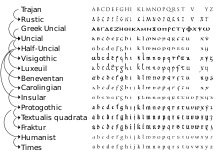| Revision as of 22:58, 22 July 2008 editTharkunColl (talk | contribs)Extended confirmed users11,561 edits Rv edits by permanently banned User:Gold heart← Previous edit |
Latest revision as of 14:38, 22 November 2024 edit undoSpringProof (talk | contribs)Extended confirmed users1,080 editsm Cleaned up using AutoEd |
| (115 intermediate revisions by 75 users not shown) |
| Line 1: |
Line 1: |
|
|
{{short description|Form of the letter g used in Insular fonts in the Old English alphabet}} |
|
] |
|
{{inline|date=September 2016}}] |
| ⚫ |
'''Insular G''' (]) is a form of the letter ] resembling a ], used in the ]. It was first used by the ], passed into ], and developed into the ] letter ]; Middle English, having reborrowed the familiar ] from the Continent, thus used two forms of g as separate letters. |
|
|
|
] |
|
|
]]] |
|
⚫ |
'''Insular G''' (]: Ᵹ, ]: ᵹ) is a form of the letter ] somewhat resembling an ], used in the medieval ] of ] and ]. It was first used in the Roman Empire in ], then it appeared in Irish half uncial (insular) script, and after it had passed into ], it developed into the ] letter ] (Ȝ ȝ). Middle English, having reborrowed the familiar ] from the Continent, began to use the two forms of g as separate letters. |
|
|
|
|
|
|
==Letter== |
|
The lowercase insular g was used in Irish ] as a phonetic character for the ], IPA /{{IPA|ɣ}}/, and on this basis is encoded in the Phonetic Extensions block of ] as of ] as U+1D79: {{unicode|ᵹ}}. |
|
|
|
], Ireland]] |
|
|
The lowercase insular g (ᵹ) was used in Irish ] as a phonetic character for {{IPAblink|ɣ}}, and on this basis is encoded in the Phonetic Extensions block of ] 4.1 (March 2005) as U+1D79. Its capital (Ᵹ) was introduced in Unicode 5.1 (April 2008) at U+A77D. The insular g is one of several insular letters encoded into Unicode. Few ] will display all of the symbols, but some will display the lowercase insular g (ᵹ) and the tironian et (]). Two fonts that support the other characters are ] and ]. |
|
|
] |
|
|
{{Unicode chart Insular}} |
|
|
|
|
|
The insular form of g is still used in traditional ]. |
|
The insular form of g is still used in traditional ]. |
|
|
|
|
|
==Turned insular g== |
|
|
A turned version of insular g (Ꝿ ꝿ) was used by ] to designate the ] ŋ.<ref>{{Cite web|url=https://www.unicode.org/L2/L2006/06266-n3122-insular.pdf|title=L2/06-266: Proposal to add Latin letters and a Greek symbol to the UCS|date=2006-08-06|first=Michael|last=Everson}}</ref> |
|
|
|
|
|
==See also== |
|
==See also== |
|
* ] |
|
|
* ] |
|
* ] |
|
|
|
|
* ] |
|
|
|
==References== |
|
|
{{reflist}} |
|
|
|
|
|
==External links== |
|
==External links== |
|
* (here mistaken for ]) |
|
* (here mistaken for ]) |
|
* shows insular g in several typefaces. |
|
* ]'s article shows insular g in several typefaces. |
|
|
|
|
⚫ |
{{Latin script}} |
|
|
|
|
| ⚫ |
{{Latin alphabet}} |
|
|
] |
|
] |
|
] |
|
] |
|
] |
|
] |
|
] |
|
|
|
|
|
| ⚫ |
{{writingsystem-stub}} |
|
|
|
|
|
|
⚫ |
{{latin-script-stub}} |
|
] |
|
|
|
{{phonetics-stub}} |
|
] |
|




